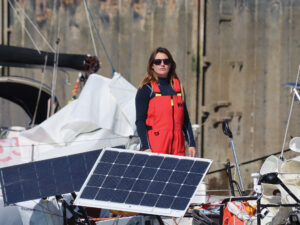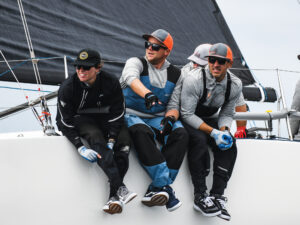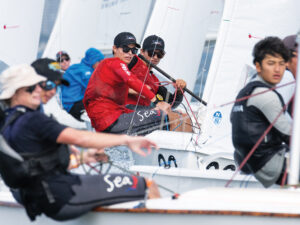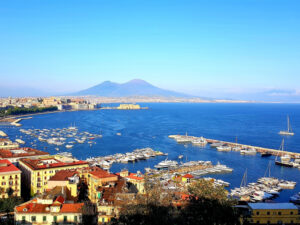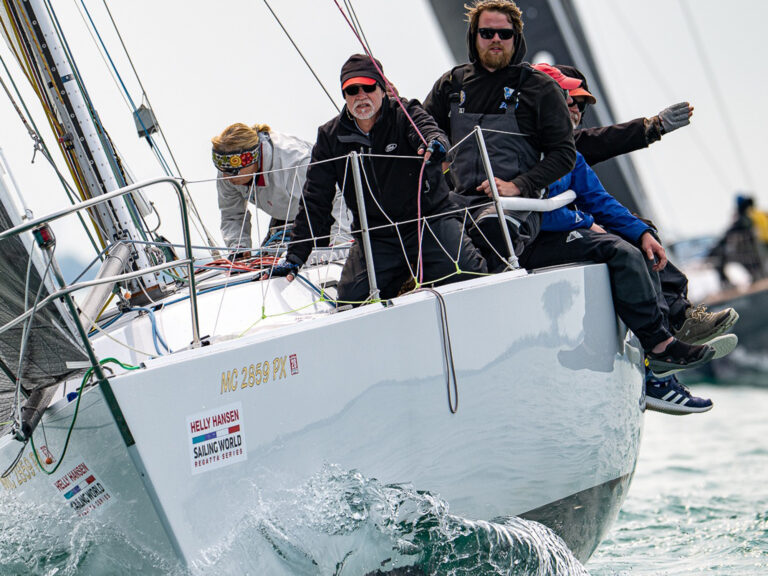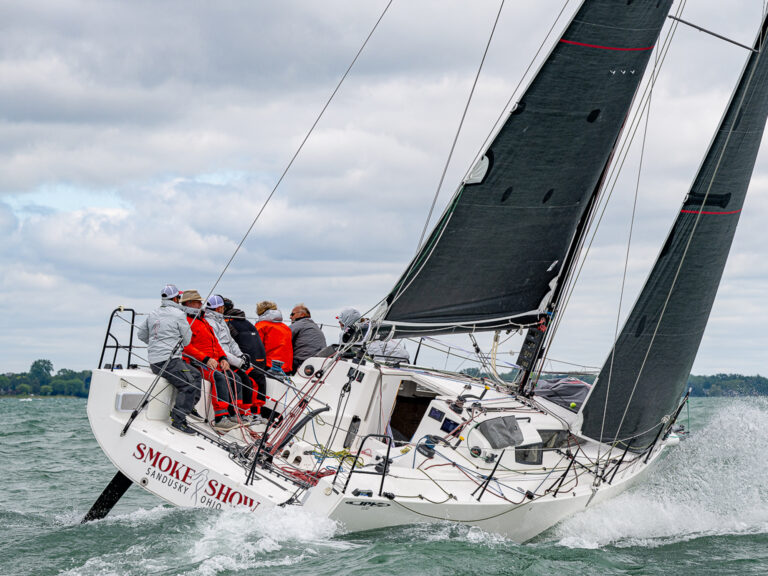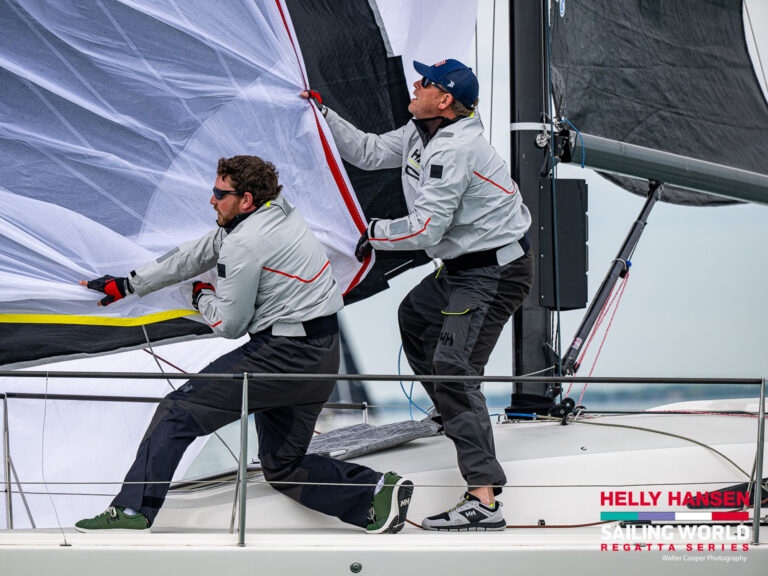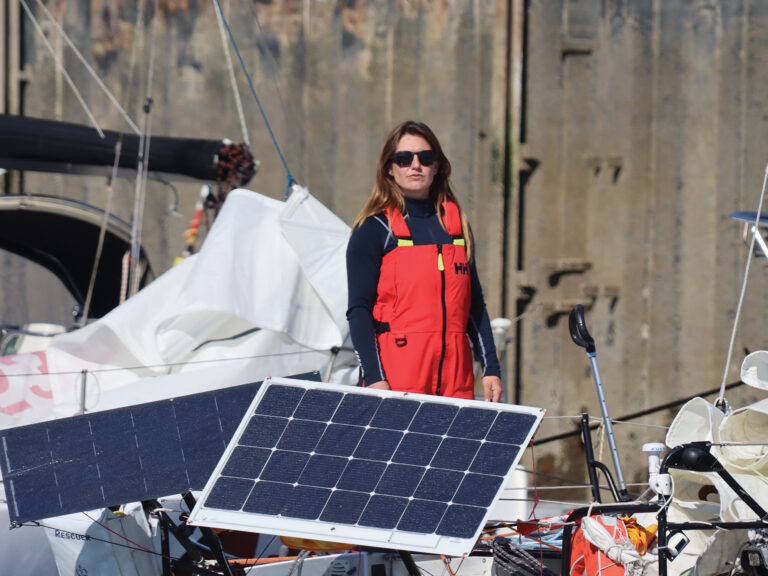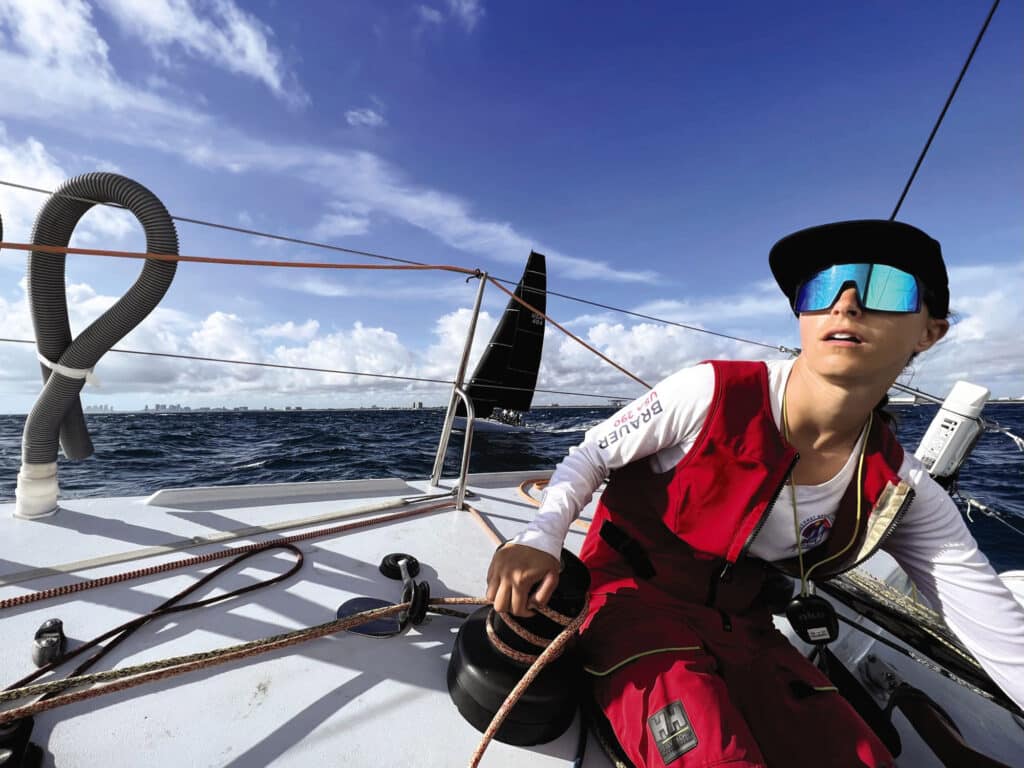
Three hours after the start of the Fort Lauderdale to Key West Race, Cole Brauer decides to switch up the game plan. “We can’t race the same way as everyone else because we don’t have a full crew,” she vents. “I have to remind myself of that.”
For the past 20 miles, Brauer and her teammate, Cat Chimney, have been short-tacking the Class40 First Light down the Miami coast to avoid the Gulf Stream, which travels north at 4 knots. With a southeasterly breeze building offshore, they must balance current relief with stronger wind offshore, choosing when to tack toward the beach and when to head out for fresh breeze. But with every tack, the competition increases their lead. Class40s aren’t known for stellar upwind speed, and the fact that Brauer and Chimney are doublehanding only makes the maneuvers slower.
“The conditions aren’t the same for everyone all the time,” Chimney responds. “I’m happy for a split here if that’s what you want to do.”
This is the duo’s first race together, and they are still getting a feel for their roles on the boat. Before today, the two had cultivated a strong professional friendship racing against each other in Class40s, often helping each other fix things before the starts of big races. A few weeks before the Fort Lauderdale to Key West Race, the Magenta Project sent them to a training session on the Canadian Ocean Racing Team’s IMOCA 60, and they instantly hit it off as teammates, deciding then and there to do more doublehanded racing together.
“All right, let’s go for a tack,” Brauer says. “We’re not going to gain by following.”
They set up at the back of the boat, with Brauer breaking the jib from her seat at the helm and Chimney trimming the new sheet on the other side.
“OK, autopilot is off,” Brauer says, clicking the remote-control puck strung around her neck.
“Copy.”
“Three, two, one, tacking.”
The boat’s bow swings through the breeze, and soon enough they’re headed out to sea. “Nice tack, Cat,” Brauer says, settling the boat onto its new heading.
For Brauer, this race is the latest development in a relatively short career in pro sailing. At 100 pounds and 5-foot-nothing, Brauer is a small person with big aspirations, yet what she lacks in size she makes up for in grit. Beginning as a boat captain, the 28-year-old has become a fixture on various sailing circuits, from distance racing to Etchells, J/70s and Melges 24s. In some ways, she’s a typical sailing bum, living in a built-out van so she can go where the wind and the gigs take her. Her career has already had many twists and turns, and she has big plans.
Brauer came late to the sport as a walk-on crew at the University of Hawaii. “I remember when I got to that first practice, people were surprised I was a girl because of my first name,” she says. “By then I was used to it, though. People still think I’m a boy if they haven’t met me in person. It’s common in this business.”
After graduating as a three-time scholar athlete with a degree in food science with a focus in medicine, medical school seemed like a logical next step. But the 2018 Pacific Cup sent her down a different path. “It was my first big offshore race,” Brauer says, “and when we got within 25 miles of shore, I got a blip of cell service, called my mom, and told her I wasn’t going to med school. I was going to go sailing instead.”
Her parents were less than stoked about their daughter abandoning a medical career to bum around on boats, but Brauer stuck to her decision, spending the year after graduation as a detailer, scrubbing teak with toothbrushes and making little money for it. “I was kind of on the struggle bus,” she says. “I could barely pay rent.”

She moved back to her home port in Boothbay Harbor, Maine, to search for sailing jobs. She was coaching to get by when she met a boat captain named Tim Fetsch, who initially wanted nothing to do with her when she asked for an apprenticeship.
“I convinced him by telling him I was small. I fit into tiny spaces, and I’d do absolutely anything to get a job,” she says. After a few weeks of steady badgering, Fetsch relented and gave her a job working on a Swan 42, her first bit of real nipper work. She took up every task thrown her way, cleaning bilges so well you could eat off them, whatever she had to do to make sure she was going to have a job the next day.
Fetsch worked for the US Merchant Marine Academy Sailing Foundation, where he managed about a dozen boats for charters and racing. Brauer started going up and down the East Coast doing deliveries on random boats, from Melges 32s to 80-foot racer-cruisers. “Usually when you’re a nipper, you’re only working on one boat under one captain,” Brauer says. “And now I was working under one boat captain, but we had a bunch of boats that we were working on.”
Fetsch taught her everything she knows, from engines to electrical. He made her install her first 110-volt outlet on a Swan 66. He taught her to see every day as a tryout and to never get too comfortable in her position. “He was brutal,” Brauer says. “But he made sure I stayed honest, made sure I worked hard and never got cocky. Looking back, Tim is the best thing that’s happened to my career. I still use those lessons today.”
Brauer worked for Fetsch for a year and a half. One day, they were walking through New England Boatworks in Portsmouth, Rhode Island, when Brauer spotted a sorry-looking Classe Mini 6.50 sitting on a trailer beneath a tarp in the boatyard. By then she’d been itching to get into singlehanded racing. She’d done some doublehanded offshore sailing in Hawaii, and she’d been doing doublehanded deliveries with Fetsch, but she wanted to take things to the next level. The Mini turned out to be a Foundation-owned boat, so she asked Fetsch if she could fix it up and campaign it.
Once again, he brushed her off, but Brauer remained persistent. Eventually, she finagled a deal with Warrior Sailing, also run through the USMMA Sailing Foundation, to refit the boat to take veterans out to learn the ropes of offshore sailing. “I don’t know if [the people at the foundation] completely believed I could do it,” Brauer says. “But they were like, ‘We’ll give her this boat and see how she does. She’ll probably give up eventually.’”
But Brauer didn’t give up. By then she’d started to have this insane idea. No American woman has ever raced singlehanded around the world, and she began to think she could be the first. “I get into a rhythm when I’m singlehanding,” Brauer says. “Everything just flows, and it works. I feel the boat, and the boat feels me. We kind of work as one, so I’m never really alone because I have the boat there.”
Eventually, she got the Mini completely refit and ready to do some serious offshore racing. But two weeks before the 2019 Bermuda 1-2, the foundation pulled its support, even though Brauer had paid the registration. “That absolutely crushed me,” she says. “I ended up stepping away from the boat after that.”
As fate would have it, she’d met Mike Hennessey on the dock earlier that season. Hennessey owned a Class40, Dragon, and Brauer started doing deliveries for him when his boat captain quit. Straight away, she badgered him for the job. “I could tell that Mike didn’t want me to take the job at first. I was 24, and I was a girl, and I was small. All these boat captains were big, 250-pound dudes in their 30s.”
Like others before him, Hennessy relented, and the two have been working together ever since. That isn’t to say it’s been an easy ride, however.
There’s a special kind of romance attached to shorthanded ocean racers, often viewed as brawny lone-wolf cowboy types who, for whatever reason, choose to battle their demons alone on the ocean rather than face them on land like the rest of us. Brauer doesn’t fit this mold. She’s good with people, even though she’s better with boats. She isn’t brawny by any means, and in cases where some men might force a repair or rigging job with brute strength, Brauer makes better use of her brain.
“You’re always going to have a tool, even if it’s the wrong tool,” she says. “Sometimes I’ll use a winch handle instead of a screwdriver if I have to.”
She plans her day to the minute, not the hour, and every task she does has a procedure, usually sketched out in long and detailed lists. Her life is not about gazing at sunsets or counting shooting stars, but about engines and electrical, and hauling sails around with halyards because she isn’t physically strong enough to do it by hand. It’s about climbing into the rudder compartment when the autopilot jams and pressing her back against the bulkhead to wriggle loose the ram from the tiller bar while the boat lays over with the kite still up, then having to go back on deck and wrangle in the pieces of a freshly broken tack clutch without getting her teeth knocked in. It’s about sitting in a harness with her legs falling asleep because she has a job to do up the mast, fighting the urge to let herself off the hook and go back down because there’s no shot she’s climbing back up to do it later, not when it’s blowing 20 knots with zero-degree temperatures. It’s about knowing that whatever comes her way, no one is there to save her if she fails.
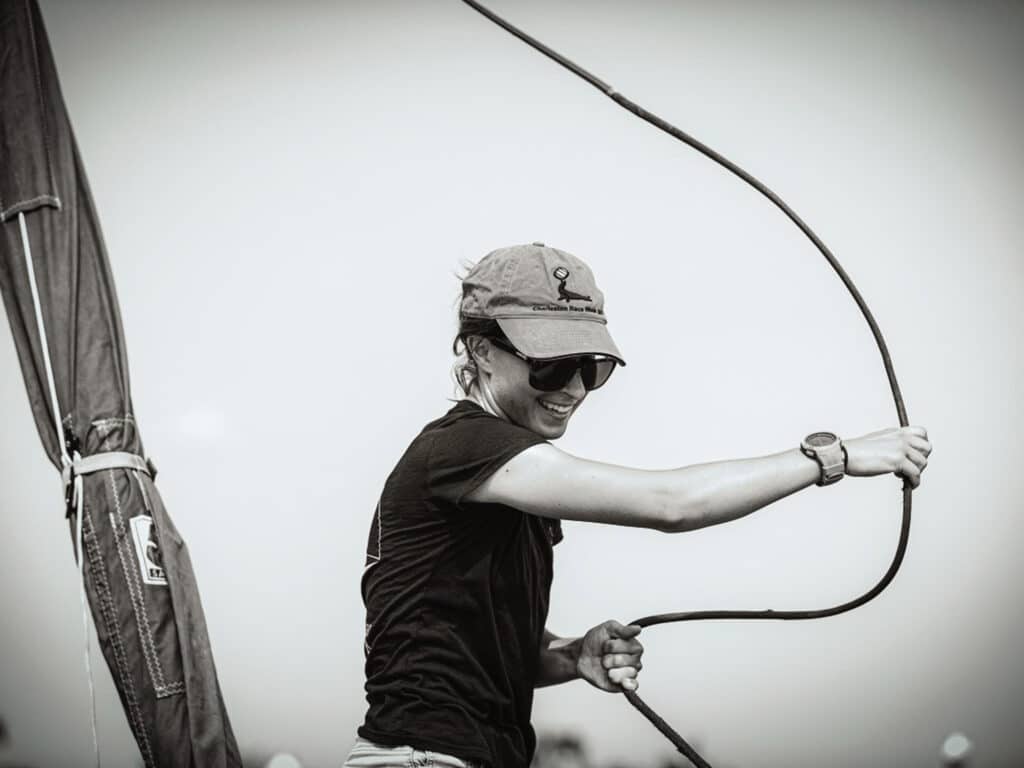
All these lessons came into use when Brauer and Hennessy lost their rig in the 2022 Caribbean 600. They’d installed brand-new rigging before completing the eight-day delivery to Antigua, but “the problem with brand-new equipment is you’re going to have teething pains,” Brauer says. “It’s the same with a brand-new engine. You have to stop every few miles and make sure everything is working properly. You trust but verify, and in this case, I didn’t verify.”
After rounding St. Barts during the race, Brauer went below to rest before she planned to hoist the Code 5. She thought they’d hit a weird wave when Hennessy began yelling, “Rig down, rig down!” Before going below, the sun was behind the mainsail, but when she glanced topside, the shade had completely vanished. When she came up, the rig had toppled over to one side. They lashed the boom to the boat and tried to get the main down, but Class40 mains have luff cars and full-length battens. The only way they could have taken it off would have been to get in the water and unwind the battens. Jumping into the ocean was not an option, and the sound of carbon and fiberglass crunching became debilitating. Brauer had never heard anything like it, and to this day, it is the worst sound she’s ever heard. When one of the winches they were using to keep the mast in the boat started pulling off the deck, they knew they were running low on options.
“Mike and I made the quick decision that we were going to lose the rig,” Brauer says.
The two began cutting halyards and unpinning side stays, trying to save anything they could salvage. “I had gone over my safety procedures for so long,” Brauer says, “so I knew where the bolt cutters were. I knew where the knives were.”
Brauer had to hit the last turnbuckle with a hammer when it got to the final thread, and after cutting more lines, they picked everything up and threw it overboard.
They’ve rebounded in a big way, however. Hennessy ended up replacing everything and getting Dragon race-ready before deciding to build a brand-new Class40 to race in France this summer. He sold Dragon to Frederick K.W. Day, owner of the Class40 Longbow, who renamed the boat First Light. Day still allows Brauer to race it as their sparring partner, with the Fort Lauderdale to Key West Race serving as their first outing together.
By the time Brauer and Chimney reach the finish, the sun has been up for two hours. The two didn’t end up finishing as strong as they’d hoped, but the main goal for this race was to arrive in one piece and see how they vibe as a team. In that sense, the test was successful, and morale is high as they tie First Light to the dock.
“What Cole is doing is really unique for her age,” says Chimney, who is eight years her senior. “She’s come into this at a really important time for women in sailing, and she deserves a lot of respect for leveraging it the way she has. These opportunities weren’t available or the culture wasn’t right when I was her age doing similar things.
“Everybody navigates pro sailing in different ways,” Chimney continues. “There’s no science behind it. It’s not like you go to college for four years and come out with a career-track job. It’s all about putting yourself in the right place with the right people and doing the best you can, and I think Cole is crushing it in that sense.”
Although she’s got some sweet gigs for the time being, Brauer has her mind set on a solo circumnavigation. She has a designer in mind to one day build an IMOCA 60 to fit her size, and in the meantime, she’ll use the Class40to rack up miles. She will continue to ignore those who doubt her because deep down, only she knows what she’s capable of. She could have taken a different path, could have gone to medical school and worked a nine-to-five, could have lived in a house instead of a van. But there’s a moment she is constantly pursuing, a moment she relishes. It’s those first few seconds after making the correct decision to do a sail change, when the wind does what it’s supposed to and the boat picks up speed, when the sail fills and the autopilot catches and the hull surfs down a wave. This is the feeling she’s chasing. This is the place she calls home, and home is wherever the wind and determination will take her.

